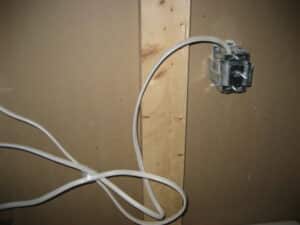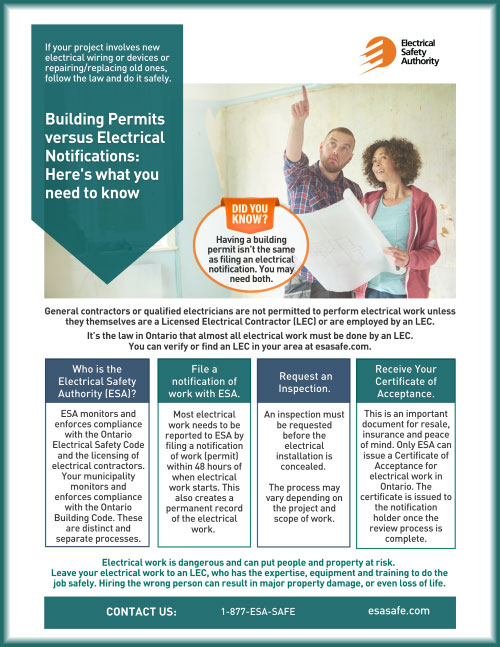Orillia Home Inspector – Electrical Inspections
As part of your home inspection, the Orillia Home Inspector will inspect the electrical service entrance, the grounding equipment as well as the condition, protective devices, posted capacity, and location of the main electrical panel. We will determine the distribution wiring material type (aluminum or copper) of the house, which might be necessary for insurance purposes. We will also verify the condition and functionality of a representative number of installed lighting fixtures, switches and electrical outlets, located inside and outside of the building. While proceeding through the home Roger will then check the polarity and grounding of the outlets inspected and will also verify the presence and operation of ground fault circuit interrupters (GFCI).
Most Common Electrical Problems Found
Unsecured Electrical Cables
This is one of the most common items I come across when inspecting basements. This is not only un-safe but it also indicates that electrical work was not done by a licensed electrician and most likely work was done without a permit or inspection.
NEC 334.30 Securing and Supporting Nonmetallic-sheathed cable shall be supported and secured by staples, cable ties, straps, hangers, or similar fittings designed and installed so as not to damage the cable, at intervals not exceeding 1.4 m (4 1⁄2 ft) and within 300 mm (12 in.) of every outlet box. junction box, cabinet, or fitting.
Electrical Cables in Contact with Heating Ducts
This is a common issue found in unfinished basements. Electrical cables are in contact with heating ducts. Typically would be fixed by installing some fiberglass insulation between the two. Pulling the electrical cable away will typically just cause the same problem somewhere else.
CEC 21st edition 2009 12-506
(4) Where non-metallic-sheathed cable is run in proximity to heating sources, transfer of heat to the cable shall
be minimized by means of an air space of at least
(a) 25 mm between the conductor and heating ducts and piping;
Ungrounded Electrical Outlets
Many older home built prior to the 1960’s were wired using older style two wire with no ground wire. I come across this issue all the time as I do inspect a lot of Century Homes, some of which still have Knob and Tube wiring installed. While a lot of the wiring in these older homes may have been upgraded, often the exterior walls will still have outlets with no ground installed. Usually they will have replaced the older two slot outlet with a more modern outlet with a ground prong opening, even though there is no ground to connect.
Fixing Ungrounded Circuits
The first fix uses Ground Fault Interrupters. There are two types of GFI available, one takes the place of the regular circuit breaker in the load center. The second type that is available takes the place of the standard outlet and replaces it with a special GFI protected outlet. These are commonly used in the kitchens and bathrooms of newer homes. Most people know them for their black and red reset buttons. I had a Master Electrician show me how he brought a grounded circuit out of main panel to an junction box in which he had installed a GFCI receptacle. The two wire electrical cable was then attached to GFCI providing some protection to ungrounded circuit.
The second fix – In many older homes the outlet mounting box was grounded but the outlet was not, if this the case it is possible to use a jumper between the mounting box and the grounding screw on the new grounded type outlet. This type of ground may not be adequate for surge protectors.
Double-Tapped Circuit Breakers
A double-tapped circuit breaker occurs when two wires are connected to one circuit breaker in a panel board. Most circuit breakers are designed for just one wire, and connecting two wires where they are not supposed to be can lead to loose connections, arcing currents and potential fires. According to an ESA inspector I consulted they will allow a 12 volt transformer for door bell etc to be added to an existing circuit breaker.
GFCI Receptacles Not Tripping When Tested
This is a fairly common problem and most home owners do not have the equipment to test their GFCI’s to verify that they work. Sometimes an electrical tester will identify a problem that the GFCI test button will not. Faulty exterior GFCI’s are common due to being exposed to the elements 24/7, older exterior covers are not as efficient and newer “Bubble Covers” which will still provide protection when a cord is plugged in.
In a typical subdivision home with 3 bathrooms, only one bathroom will have a GFCI outlet. The other two bathrooms are connected downstream to this GFCI outlet which then provides protection to the other bathrooms on the same circuit. Many times I find a home owner has replaced the bathroom receptacle with a GFCI receptacle not realizing the circuit is already protected. So now when that GFCI outlet is tested, the original GFCI in another bathroom will also trip.
Electrical Panel in Bathroom
This is never permitted.
Clearances for Service Panel Board
This rule for working space clearances required for any panel board installed in your home. Many times I find people have installed kitchen cupboards over their panel, installed washers and dryers in front of panel or built a box around panel and covered with a small door. This typical scenarios all violate the Canadian Electrical Code.
Sec. 110-26 of the National Electrical Code (NEC): 1) at least a 3-ft clearance in front of all electrical equipment; 2) a 30 in.-wide working space in front of equipment operating at 600V or less; and 3) minimum headroom clearance of 6 feet or the height of the equipment, whichever is greater.
Electrical Permit Required
When your home has improperly installed electrical wiring or fixtures, this is a good indication that work was done without a Building Permit or Required Inspections. If the home you are thinking of buying has a finished basement and there are some electrical deficiencies found, think of how many defects maybe hidden behind finished walls and ceilings. Plumbing Defects and Problems with your homes major systems may also be affected.
When electrical defects are found or repairs are needed it is always recommended that you have a Licensed Master Electrician inspect and repair any electrical deficiencies. Your families safety is not worth risking for the sake of saving a couple of dollars.
File a Notification of Work with ESA
The Ontario Electrical Safety Code (the Code) requires almost all electrical work be reported to the Electrical Safety Authority by filing a notification of work (or “permit”). An electrical notification of work creates a permanent record of the electrical work that has been done in your home and it triggers a review process by ESA. The person doing the work (you or a Licensed Electrical Contractor) should file the notification before the work starts.
Hire a Licensed Electrical Contractor
Electrical work is dangerous and can put you and your loved ones at risk. Leave your electrical work to the professionals. In Ontario, if you hire someone to do electrical work in your home, by law, it must be a Licensed Electrical Contractor (LEC). It is the only way to be sure that your electrical work is safe and legal.
Your LEC will file the electrical notification of work and request an inspection. They can also provide the ESA Certificate of Acceptance for your insurance company. Remember to ask for a copy. Learn more about Hiring a Licensed Electrical Contractor.
If you hire a general contractor, confirm that a Licensed Electrical Contractor will do the electrical work.
 Call Roger Frost at 705-795-8255
Call Roger Frost at 705-795-8255
Send Roger an Email – [email protected]
CERTIFIED BUILDING CODE OFFICIAL
CERTIFIED MASTER INSPECTOR
ABOUT US
Home
Pricing
Guarantee
Training
Air Quality Testing
Guarantee
Contact Us
Home Tips
Testimonials
Asbestos
Thermal Imaging
INSPECTION AREAS
Angus
Alliston
Barrie
Brechin
Coldwater
Hawkestone
Innisfil
Midland
Muskoka
Penetanguishene
Ramara
Washago



